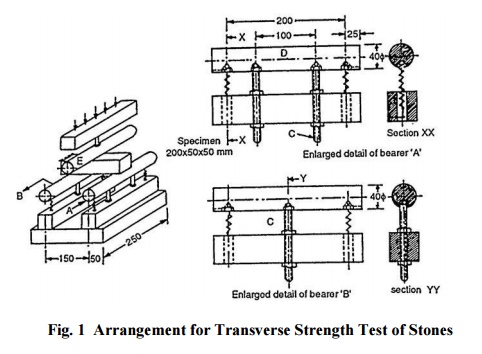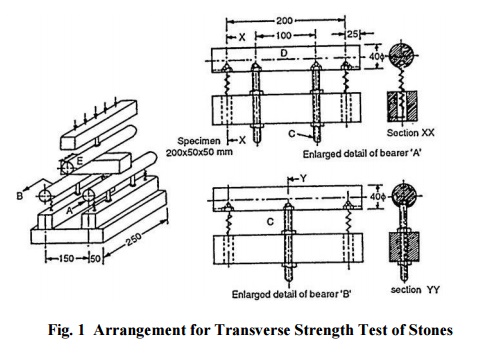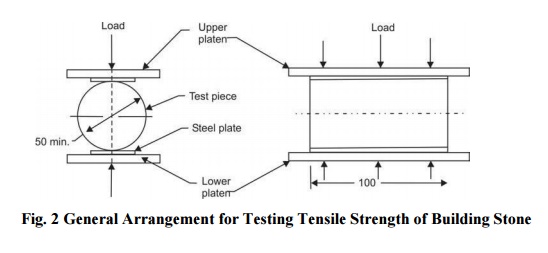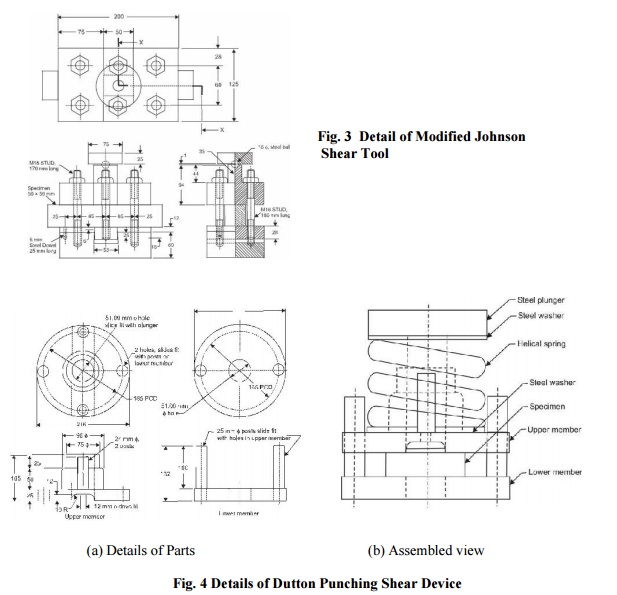Chapter: Civil : Construction Materials: Stones, Bricks,Concrete Blocks
Testing Of Stones

Testing Of Stones
Building stones are available in large quantity in various
parts of the country and to choose and utilize them for their satisfactory
performance, it is necessary to test the stone for its strength properties,
durability and quality.
Durability Test: Some of
the tests to check the durability of stone are as follows. Of these tests, the
crystallization test is prescribed by Bureau of Indian Standards. The
durability (soundness) test is performed to find out the capacity of stone to
resist disintegration and decomposition.
Smith Test: Break off
the freshly quarried stone chippings to about the size of a rupee coin and put
them in a glass of clean water, one-third full. If the water becomes
slightly cloudy, the stone is good and durable. If water becomes dirty, it
indicates that the stone contains too much of earthy and mineral
matter.
Brard's Test -
for
frost resistance - Few small
pieces of freshly quarried stone are immersed in
boiling
solution of sulphate of soda (Glauber's salt) and are weighed. These are then
removed and kept
suspended for few days and
weighed again. The loss in weight indicates the probable effect of frost. Acid
Test - to check weather resistance - confirms
the power of stones to withstand the atmospheric conditions. 100 g of
stone chips are kept in a 5 per cent solution of H2SO4 or
HCI for 3 days. Then the chips are taken out and dried. The sharp and firm
corners and edges are indication of sound stone. This test is used to test the
cementing material of sand stone.
Crystallization
Test (IS 1126): Three test pieces of 50 mm diameter and 50 mm
height are dried for 24 hours and are weighed (W1). The
specimens are suspended in 14 per cent sodium sulphate solution (density 1.055
kg/m3) for 16 to 18 hours at room temperature (20 o to 30 o C). The
specimens are then taken out of the solution and kept in air for 4 hours. They
are then oven dried at a temperature of 105 o ± 5 o C for 24 hours and then cooled
at room temperature. This process is repeated for 30 cycles. The specimens are
weighed (W2) and the difference in weight is found. This test is
repeated thirty times and the loss in weight after every five cycles is
obtained. The change in weight indicates the degree of decay of stone. Durability
should be expressed in percentage as change in the weight. The average of three
test results should be reported as durability value.
Change in
weight = W2/W1
where W1 is the
original weight of the specimen and W2 is the weight of the specimen
after 30 cycles of the test.
Crushing Test
Compressive Strength Test (IS:
1121 (Part I)) Samples of stone weighing at least 25 kg each of
the unweathered spcimen should be obtained from quarry. To test stone
for compressive strength, specimen pieces in the form of cubes or cylinders are
made from samples of rock. The lateral dimension or diameter of test piece
should not be less than 50 mm and the ratio of height to diameter or lateral
dimension should be 1:1. A minimum of three specimen pieces are tested in each
saturated and dry conditions. Separate tests should be made for the specimen
when the load to parallel to the rift and perpendicular to the rift. In all
twelve test pieces should be used.
The
specimen pieces of diameter or lateral dimension 50 mm are immersed in water at
20 to 30 o C for 72 hours and are tested in saturated condition. The specimen
pieces are also tested in dry condition by drying them in an oven at 105 ± 5 o C
for 24 hours and then cooled in a desiccator to 20 -30 o C.
These are tested in universal testing machine. The load is applied gently at a
rate of 14 N/mm2 per minute until the resistance of the specimen
piece to the increasing load breaks down and no greater load is sustained.
The compressive strength of the
specimen piece is the maximum load in Newtons supported by it before failure
occurs divided by the area of the bearing face of the specimen in mm2.
The average of the three results in each condition separately should be taken
for the purpose of reporting the compressive strength of the sample.
When the
ratio of height to diameter or lateral dimension differs from unity by 25 per
cent or more, the compressive strength is calculated by the following
expression.
Cc=Cp /
EbO 0.778 0.222 É Ù Ê h Ú
where Cc =
compressive strength of standard specimen piece
Cp =
compressive strength of the specimen having a height greater than the diameter
or lateral dimension
b = diameter or lateral dimension
h = height
The crushing strength of stones varies in the range of 15-100 N/mm2.
Transverse Strength Test (IS:
1121 (Part II)): To test stone for transverse strength, specimen
pieces are made in the form of blocks 200 × 50 × 50 mm. These are tested
in saturated and dry conditions similar to as explained in the compressive
strength test. Test apparatus used for testing is shown in Fig. 1. Each
specimen piece is supported upon two self-aligning bearers

A and B, 40 mm in diameter, the
distance between centres of bearers being 150 mm. Bearer A is supported
horizontally on two bearer screws C, which carry hardened steel balls D. Bearer
B is supported on one such bearer screw and ball. The load is then applied
centrally on the specimen piece at a uniform rate of 2 kN/min through a third
bearer E, also 40 mm in diameter, placed midway between the supports upon the
upper surface of the specimen S and parallel to the supports.
The
average of the three results (separately for saturated and dry condition)
should be taken for the purpose of determining transverse strength of sample.
Any specimen giving result as much as 15 per cent below the average value
should be examined for defects.
The
transverse strength of the specimen is given by
R = 3WL/2bd3
where R = transverse strength in N/mm2
W =
central breaking load in N
L =
length of span in mm
b =
average width in mm of the test piece at the mid section
d =
average depth in mm of the test piece at the mid section
Tensile Strength Test (IS: 1121 (Part III))
Three
cylindrical test pieces of diameter not less than 50 mm and the ratio of
diameter to height 1:2 are used to determine the tensile strength of the stone
in each saturated (kept in water for 3 days at 20 to 30 o C) and dry condition
(dried in an oven at 105 ± 5 o C for 24 hours and cooled at room temperature).
The general arrangement for testing tensile strength of stone is shown in Fig.
3.11. Each test piece to be tested is sandwiched in between two steel plates of
width 25 mm, thickness 10 mm and length equal to the length of test piece. The
load is applied without shock and increased continuously at a uniform rate
until the specimen splits and no greater load is sustained. The maximum load
applied to the specimen is recorded.

Split
tensile strength,
S= 2W/SdL
where
S = split tensile strength (N/mm2) W = applied load
(N)
d = diameter of specimen (mm), and L = length of specimen (mm)
The
average of three results separately for each condition should be reported as
split tensile strength of the sample. In case any test piece gives a value of
as much as 15 per cent below the average, it should be examined for defects and
if found defective the test piece should be rejected.
Shear Strength Test (IS: 1121 (Part IV))
The test is carried out either in
Jhonson shear tool (Fig. 3) or Dutton punching shear device (Fig. 4). Three
test pieces are used for conducting the test in each of the saturated and dry
condition.
Test piece for use in Jhonson
shear tool should be bars 50 × 50 mm in section and not less than 100 mm in
length and that for use with the Dutton punching shear device should be slabs
30 mm in thickness, 100 mm in width and not less than 100 mm in length.

Using Jhonson Shear Tool
The test
piece is carefully centred in the shear tool and the bolts drawn up tightly.
The tool is then centred in the testing machine with the centre of the
spherical block in contact with the centre of the top portion of the plunger of
the shear tool. The speed of the moving head of the testing machine during load
application should not be more than 1 mm/min. During the test, the beam of the
testing machine should be kept constantly in floating position. The shear
strength of test piece is calculated by
S=W/2A
where
S = Shear strength (N/mm2) W = total maximum load
(N)
A = area of the centre cross-section of test piece (mm2)
The average of all the three results separately
for each condition is calculated and taken as the shear strength of the test
piece.
Using Dutton Punching Shear Device
Centre
lines are laid over one surface of the slab. Thickness of the slab is measured
at three points approximately equidistant around the circumference of a 50 mm
circle centred on the intersection of the two center lines. The test piece is
centred in the punching device keeping it under the plunger. The punching
device is then centred in the testing machine with the centre of the spherical
bearing block in contact with the centre of the top portion of the plunger of
the shear device. The speed of the moving head of the testing machine during
load application should not be more than 1 mm/min. During the test, the beam of
the testing machine should be kept constantly in floating position. The shear
strength of the test piece is calculated by
S= WtWi SDT
where
S = Shear strength (N/mm2) Wt = total
maximum load (N)
Wi = initial load (N)
required to bring the plunger in contact with the surface of specimen D =
diameter (mm) of the plunger
T=
thickness (mm) of the specimen
The average of all the three results separately
for each condition is calculated and taken as shear strength of the test piece.
Absorption Test (IS: 1124)
The selected test pieces of stone are crushed or broken and
the material passing 20 mm IS Sieve and retained on 10 mm IS Sieve is used for
the test. The test piece weighing about 1 kg is washed to remove particles of
dust and immersed in distilled water in a glass vessel at room temperature 20
to 30 o C for 24 hours. Soon after immersion and again at the end of soaking period, entrapped air is removed by
gentle agitation achieved by rapid clock-wise and anti-clock-wise rotation of
the vessel. The vessel is then emptied and the test piece allowed to drain.The
test piece is then placed on a dry cloth and gently surface dried with the
cloth. It is transferred to a second dry cloth when the first one removes no
further moisture. The test piece is spread out not more than one stone deep on
the second cloth and left exposed to atmosphere away from direct sunlight or
any other source of heat for not less than 10 minutes untill it appears to be
completely surface dry. The sample is then weighed (B).
The sample is then carefully
introduced in a 1000 ml capacity measuring cylinder and distilled water is
poured by means of 100 ml capacity measuring cylinder while taking care to
remove entrapped air, untill the level of water in the larger cylinder reaches
1000 ml mark. The quantity of water thus added is recorded in ml or expressed
in gram weight (C).
The water
in the larger cylinder is drained and the sample is carefully taken out and
dried in an oven at 100 to 110 o C for not less than 24 hours. It is then cooled
in a desiccators to room temperature and weighed (A). The room temperature
during the test is recorded.
Apparent
specific gravity = A/1000C
Water
absorption = BA - 100 / A
Apparent
Porosity = BA-100 / C . 1000
The true
porosity shall be calculated from the following formula:
True
Porosity = [ True specific gravity - Apparent
specific gravity ] / True Specific
gravity
Where
A = Weight of oven-dry test piece (g)
B = Weight of saturated surface-dry test piece (g)
C = Quantity of water added in 1000 ml jar containing the test
piece (g)
Hardness: This test is performed by
scratching a stone with knife on Mohs scale.
Toughness:
This
test is performed by breaking the stone with a hammer. Toughness is indicated
by resistance to hammering.
Related Topics